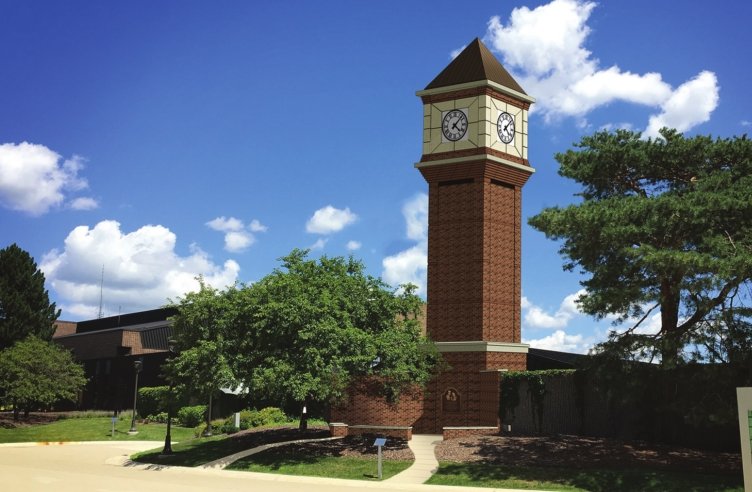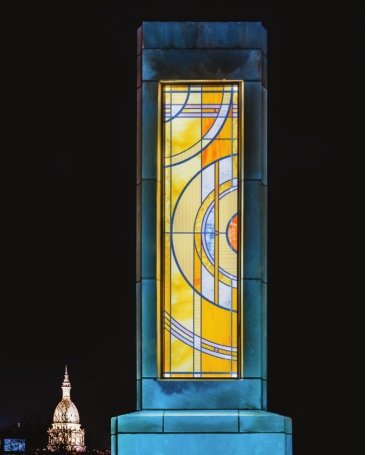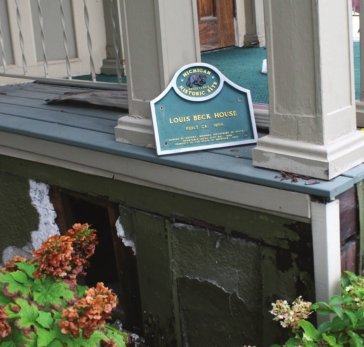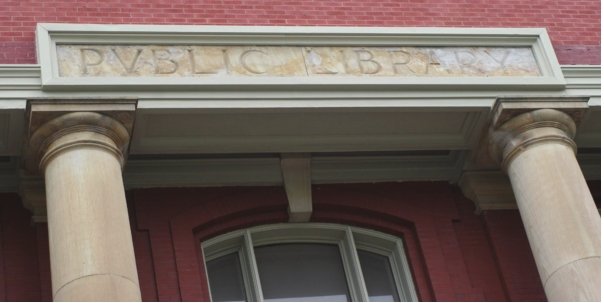
Four projects on the downtown campus of Lansing Community College smack of mystery, but collectively they tell the latest chapter of a familiar story.
LCC’s perimeter has long been a battleground of two spirits: the college’s seemingly primal urge to brand itself by marking its territory, and its willingness to blend into the surrounding urban fabric via preservation of existing structures.

The tug of war between branding and blending literally reached new heights two weeks ago, when the college announced it would erect a 6-story-tall clock tower at the south entrance of the campus, near the intersection of Shiawassee Street and Washington Square.
At that height, the tower will be the most conspicuous thing around and a strong assertion of LCC’s downtown presence, especially to motorists cruising west over the Grand River on the Shiawassee Street bridge. But early renderings of the tower suggest a quiet, quasi-College Gothic design redolent of the Ivy League, or at least a highend shopping mall, with nary an electronic signboard or LCC logo in sight. Work on the tower will start soon, with an expected completion date by the end of fall, just in time to ring in LCC’s 60th anniversary.
The four-sided, backlit tower will build from an existing, mushroom-like oddity built in the 1970s in the bunker-like, Brutalist style that dominated the LCC campus until its recent spate of glassy, post-modern renovations. The old tower housed welding classes 30 years ago but has been empty for years.

Glenn Granger, president and CEO of Granger Construction Co., and his wife, Trish, donated the money to build the tower, which is expected to cost about $300,000 and will be named Granger Tower. The tower will be dedicated to Glenn Granger’s parents, Alton and Janet Granger, to recognize their support of education through the Granger Foundation.
The college hopes the tower will be an “icon” and gathering spot more lasting than the popular nearby Pokemon Go gym in front of the Gannon Building, said Tonya Causley, a spokeswoman for LCC President Brent Knight.
LCC has installed conspicuous signage in several spots along its perimeter, but this summer saw the arrival of a more graceful marker: a decorative column 18 feet high that now stands watch on the west edge of campus, at the corner of Shiawassee and Seymour streets. The 70-year-old, threesided column was salvaged from the Lansing YMCA on Lenawee Street and was donated to LCC in 2015 by its former owners, Julie Lawton-Essa and Dan Essa. Its original stained glass panel was replaced by a sturdier glass coated by a film embossed with an Art Deco design.
Mason Dan Schiffer, formerly of Schiffer Contractors, donated his time to dismantle and reassemble the slender, fluted column.
Not far from the YMCA column, on the west edge of campus, branding infamously won out over blending in 2012, when LCC demolished three century-old houses at the corner of Saginaw Street and Capitol Avenue to build a low, free-standing brick logo wall and a pocket park.

The college learned its lesson from the resulting bad press and opprobrium in Lansing’s preservation community, according to Causley. This summer, workers began another project, tearing some of the vinyl siding from the Louis Beck House at 515 N. Capitol Ave.. to inspect the house’s stone foundation and begin work on making the house usable. LCC bought the house in December 2012 but since then it’s been used for storage.
The house, designated a Michigan historic site in 1991, was built in 1890 by Lansing clothiers Louis and Sarah Beck and stayed in the Beck family until 1958, when it was converted to commercial offices. The house most recently housed the Michigan Sheriffs Association.
The first priority, Causley said, is to “get it structurally more sound.” Stonework is crumbling around the foundations and the porch is sinking.
LCC history instructor David Siwik, who looked into the house’s history, called it “a classic example of vernacular architecture” built in a foursquare style called Prairie Box. A “truly authentic restoration” might entail tearing off the vinyl siding and doing some tricky stucco work, according to Siwik, but Causley said LCC will work with the Historical Society of Greater Lansing on the restoration.
“We want to be great neighbors,” Causley said.
The college doesn’t have an estimate of the scope or cost of restoration yet and hasn’t decided what it will use the building for.
The strangest manifestation of LCC’s branding-versus-blending drama is Lansing’s 1903, Victorian-era Carnegie Library at 210 W. Shiawassee, the city’s main library until 1963. When the library became an annex to LCC’s University Center, its grand entrance was deliberately blocked by a bunker of shrubs and the grand front doors were turned into a window, drawing scorn from local preservationists and earning City Pulse “eyesore of the week” recognition six years ago.
Last summer, the college began a partial restoration of the library’s long-abused façade. Stern-carved letters reading PVBLIC LIBRARY above the entrance were uncovered and elegant fish-scale patterns etched into the windows are being cleaned and restored.
The entrance is still a strange compromise. The current restoration includes newly installed “fake doors to give it some presence,” in Causley’s words — they don’t open — and the steps are still blocked by foliage. There are no immediate plans to make the entrance, or at least the steps, accessible. Causley said the college is hoping to install more “faux stained glass” on the surrounding windows, new molding and a clock face to the library’s façade.
Some of the new features planned, such as the clock face, aren’t meant to restore the library’s original look. “It won’t be really taking it back to the historical,” Causley said, “but it will at least have a nice appearance from the street.”
Support City Pulse - Donate Today!
Comments
No comments on this item Please log in to comment by clicking here